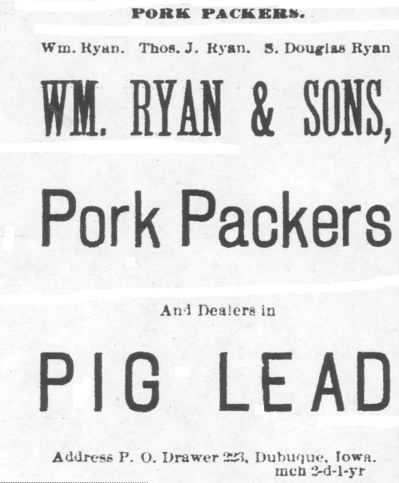Encyclopedia Dubuque
"Encyclopedia Dubuque is the online authority for all things Dubuque, written by the people who know the city best.”
Marshall Cohen—researcher and producer, CNN
Affiliated with the Local History Network of the State Historical Society of Iowa, and the Iowa Museum Association.
RYAN, William A.: Difference between revisions
No edit summary |
No edit summary |
||
| Line 1: | Line 1: | ||
RYAN, William A. (Shepardstown, WV, July 10, 1820--Dubuque, IA, Sept. 6, 1890). Owner of one of the most profitable meatpacking companies in the early Midwest. A resident of Galena, Illinois, from 1846 to 1868, Ryan became a personal friend of Ulysses S. Grant. This friendship allowed the packing company owned by Ryan and his brother James to enjoy continuous orders for dressed pork during the [[CIVIL WAR]]. | RYAN, William A. (Shepardstown, WV, July 10, 1820--Dubuque, IA, Sept. 6, 1890). Owner of one of the most profitable meatpacking companies in the early Midwest. A resident of Galena, Illinois, from 1846 to 1868, Ryan became a personal friend of Ulysses S. Grant. This friendship allowed the packing company owned by Ryan and his brother James to enjoy continuous orders for dressed pork during the [[CIVIL WAR]]. | ||
Ryan moved to Dubuque in 1868 to establish a meat packing company and met with immense success. The huge packinghouse located on the levee and Jones Street thrived until 1896 when fire destroyed the business. | [[Image:Wm.jpg|left|thumb|350px|Advertisement. Photo courtesy: William K. Hammel]]Ryan moved to Dubuque in 1868 to establish a meat packing company and met with immense success. The huge packinghouse located on the levee and Jones Street thrived until 1896 when fire destroyed the business. | ||
In Dubuque, Ryan is perhaps as well remembered for his homes done in [[ITALIAN VILLA ARCHITECTURE]]. The house at 1389 Locust Street was designed by the famed architect Van Osdel who was also commissioned to design Chicago's Palmer House. Ryan moved into the house in 1871 with his wife Ann Eliza Dignan and their children, Stephen Douglas, Thomas Jefferson, John William, Arthur Edward, William Jr., Imogene, and Anne Isabel. | In Dubuque, Ryan is perhaps as well remembered for his homes done in [[ITALIAN VILLA ARCHITECTURE]]. The house at 1389 Locust Street was designed by the famed architect Van Osdel who was also commissioned to design Chicago's Palmer House. Ryan moved into the house in 1871 with his wife Ann Eliza Dignan and their children, Stephen Douglas, Thomas Jefferson, John William, Arthur Edward, William Jr., Imogene, and Anne Isabel. | ||
Revision as of 02:35, 27 January 2009
RYAN, William A. (Shepardstown, WV, July 10, 1820--Dubuque, IA, Sept. 6, 1890). Owner of one of the most profitable meatpacking companies in the early Midwest. A resident of Galena, Illinois, from 1846 to 1868, Ryan became a personal friend of Ulysses S. Grant. This friendship allowed the packing company owned by Ryan and his brother James to enjoy continuous orders for dressed pork during the CIVIL WAR.
Ryan moved to Dubuque in 1868 to establish a meat packing company and met with immense success. The huge packinghouse located on the levee and Jones Street thrived until 1896 when fire destroyed the business.
In Dubuque, Ryan is perhaps as well remembered for his homes done in ITALIAN VILLA ARCHITECTURE. The house at 1389 Locust Street was designed by the famed architect Van Osdel who was also commissioned to design Chicago's Palmer House. Ryan moved into the house in 1871 with his wife Ann Eliza Dignan and their children, Stephen Douglas, Thomas Jefferson, John William, Arthur Edward, William Jr., Imogene, and Anne Isabel.
To provide additional privacy, Ryan had a two story wooden fence erected between his house and that of his neighbor, John THOMPSON. Ryan's wife died on March 26, 1872, and he remarried.
Ryan later purchased the Thompson house, constructed in 1873, and with his second wife, Catherine Brown Ryan, and their children Alice, Eugene, John Arthur, James Albercht, and Genevieve moved in during 1885. The fence was removed and despite its size, thirty rooms and three stories, the new Ryan house was moved thirteen feet to the south. Evidence of the new and old foundations may be seen today in the basement of the Ryan House where gaps between the two foundations were filled with bricks.


